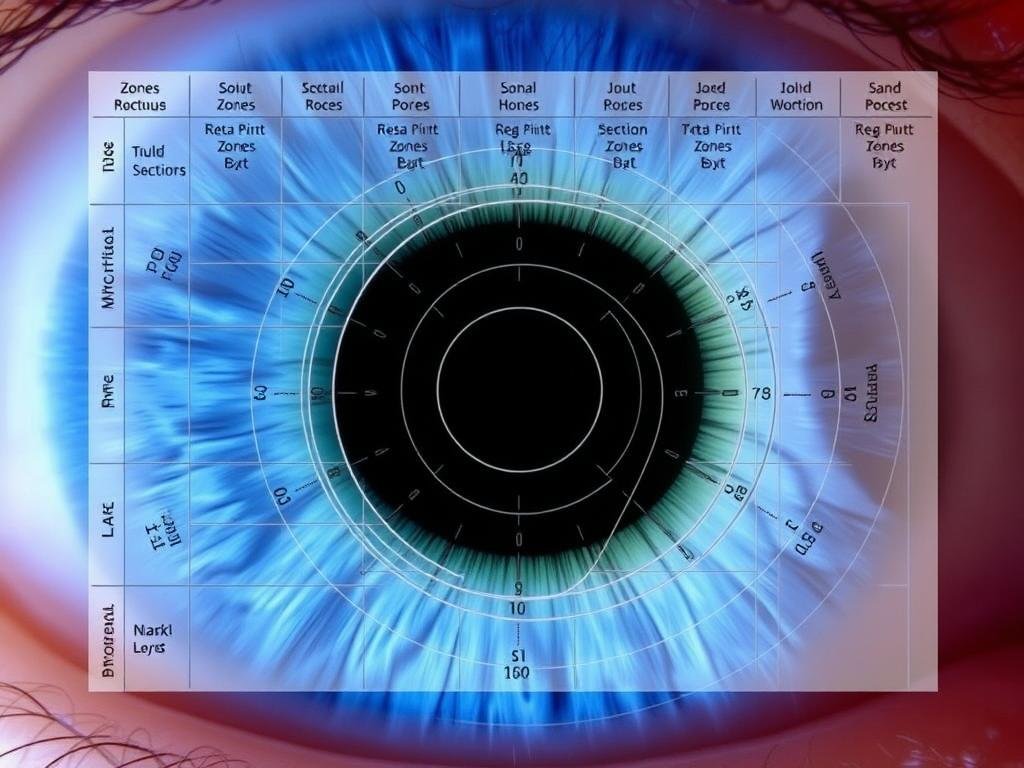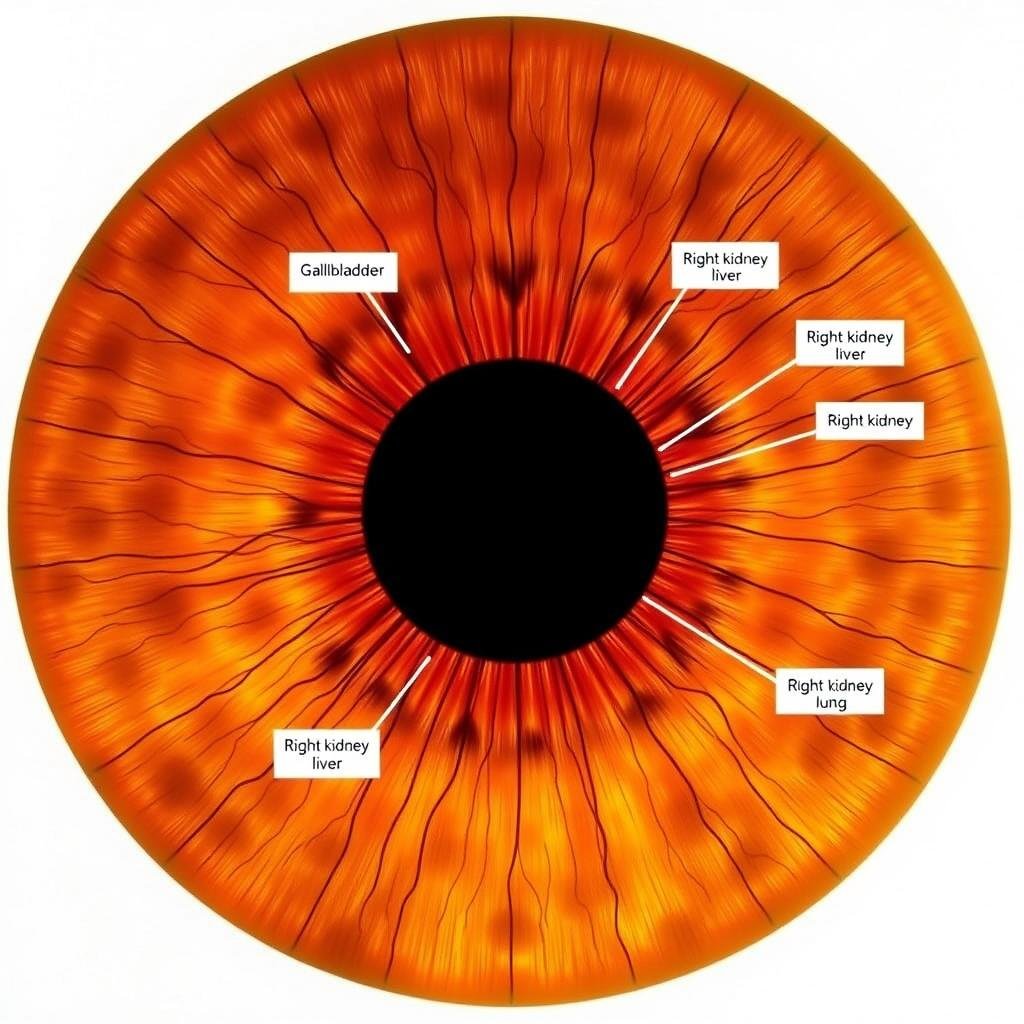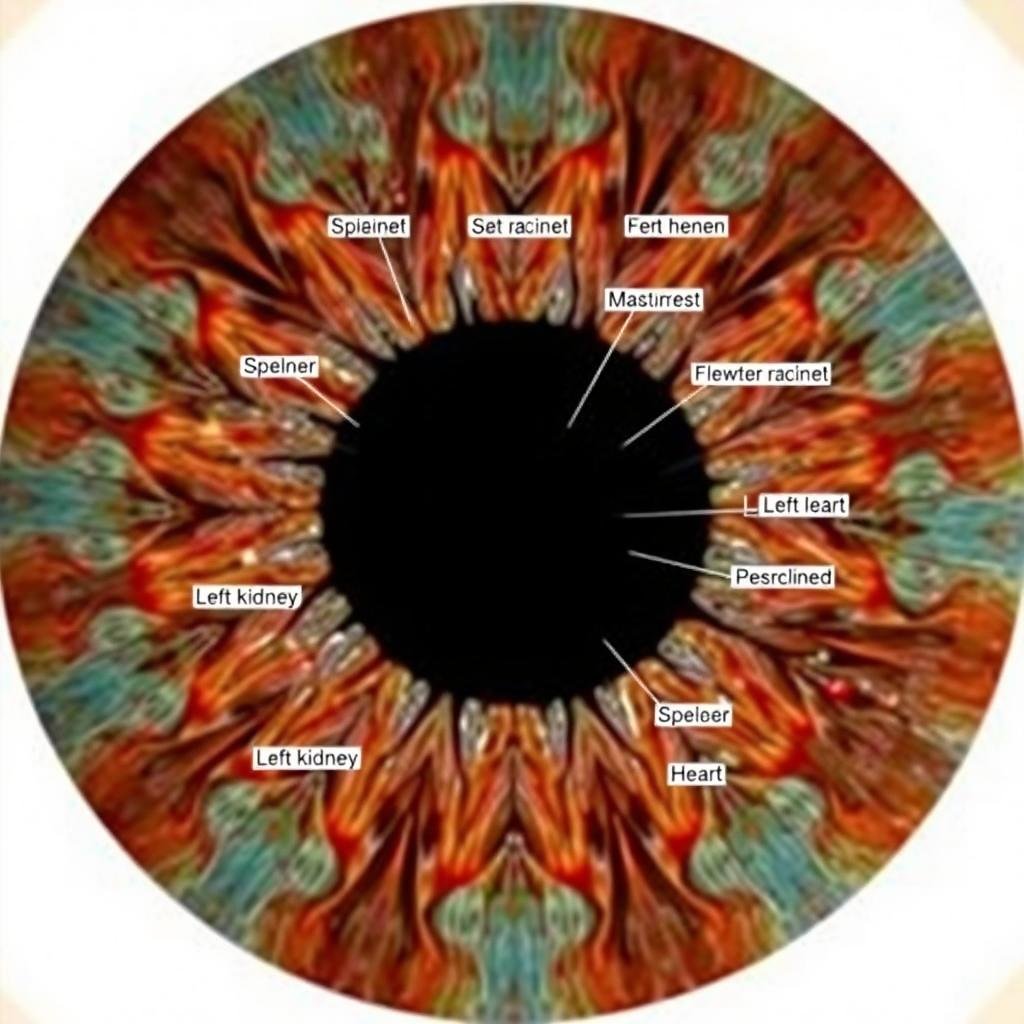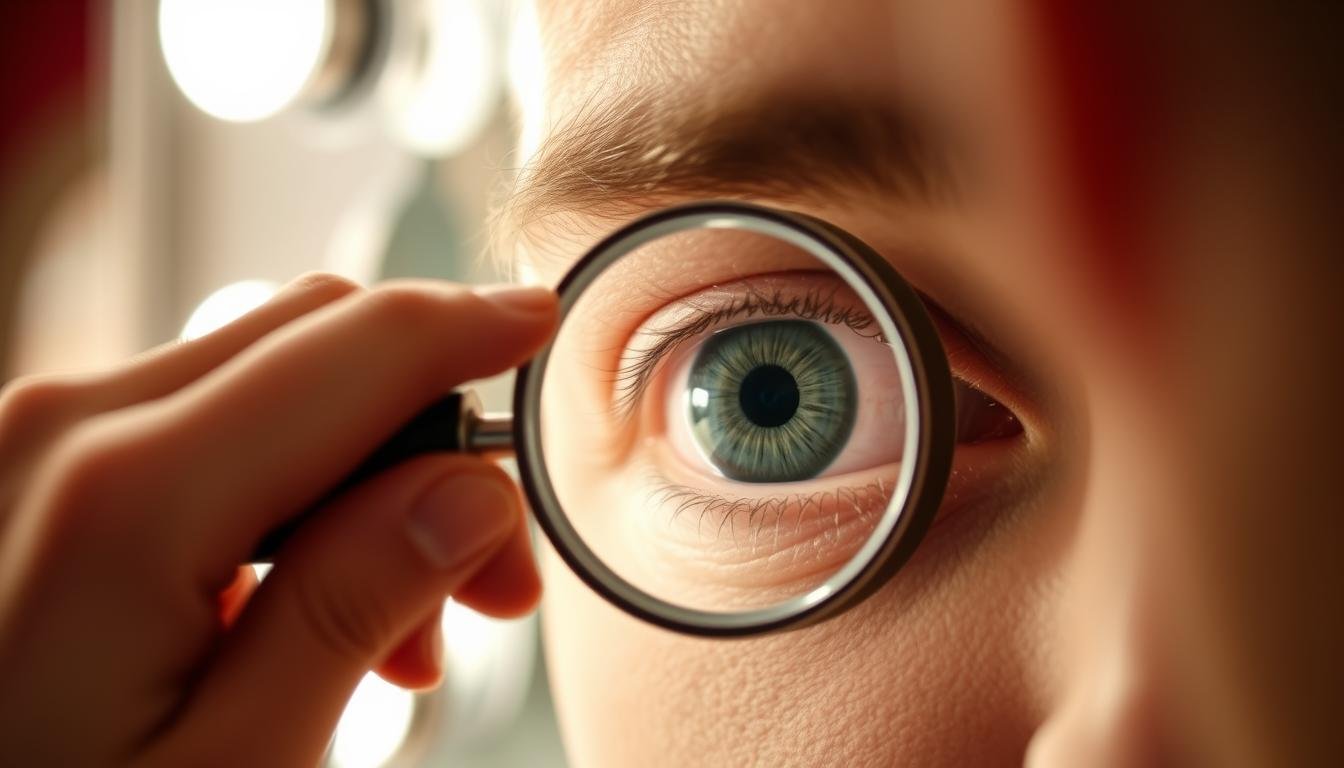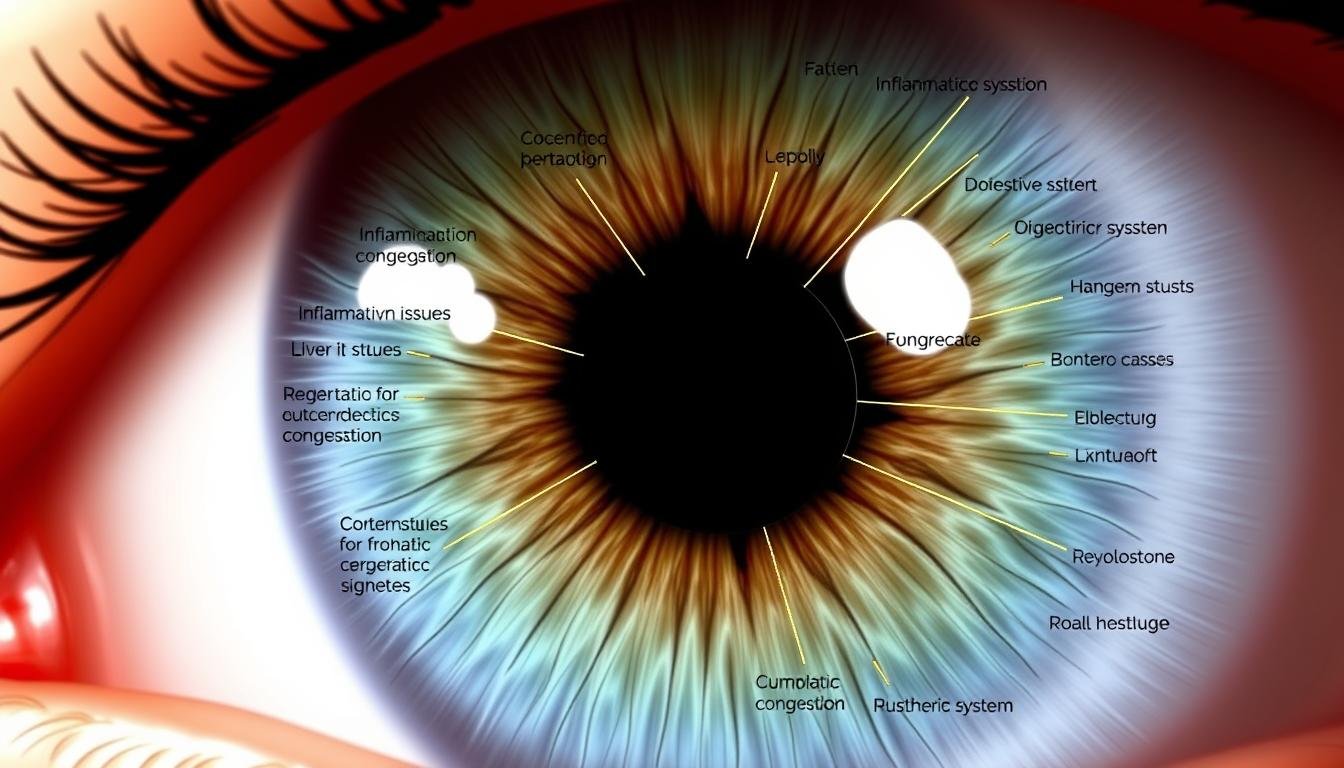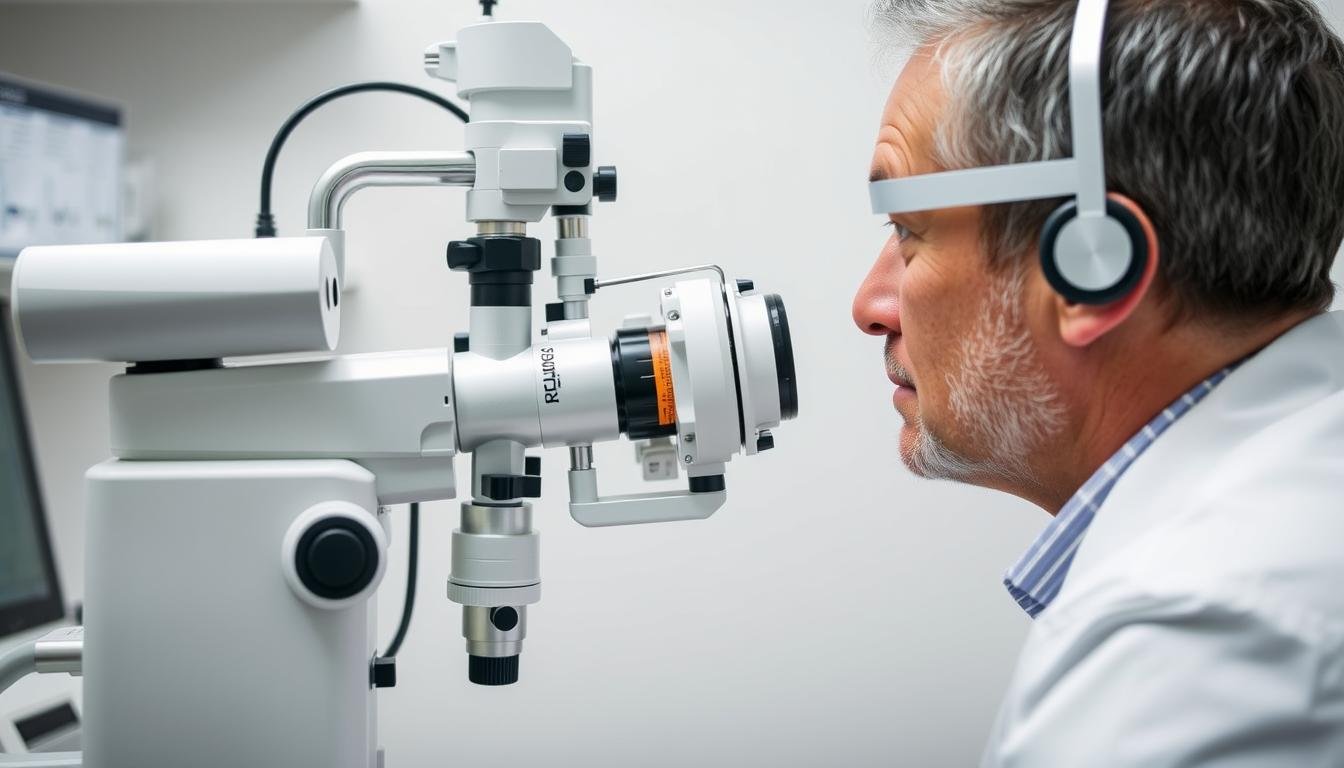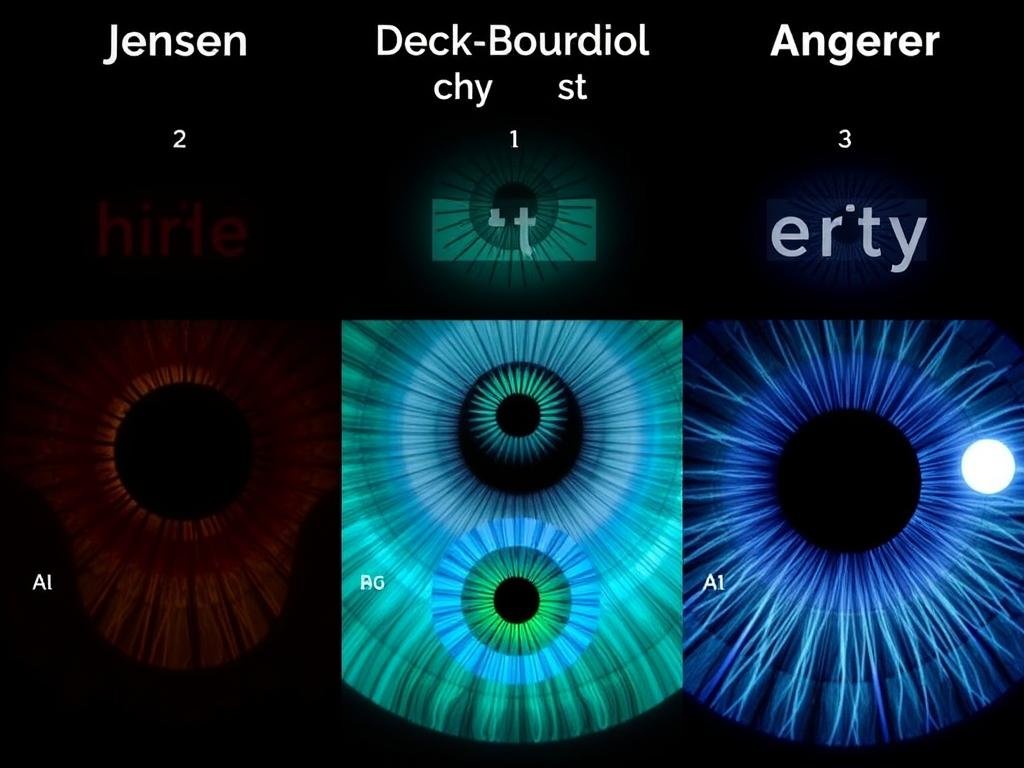A íris humana contém padrões intrincados tão únicos quanto impressões digitais. Os gráficos iridológicos mapeiam esses padrões para diferentes sistemas corporais, criando uma janela fascinante para possíveis condições de saúde. Este guia abrangente explora como os profissionais usam o gráfico iridológico, suas origens históricas e o debate contínuo sobre sua eficácia na medicina alternativa.
O que é um gráfico de iridologia?
Um gráfico de iridologia serve como um mapa detalhado que divide a íris em zonas, cada uma correspondendo a diferentes órgãos e sistemas do corpo. Os profissionais usam esses gráficos para analisar a cor, a textura e as marcas da íris para identificar possíveis desequilíbrios de saúde antes que se manifestem como sintomas físicos.
Um gráfico de iridologia padrão que mapeia zonas da íris para sistemas corporais correspondentes
Esses gráficos especializados fornecem uma estrutura para os iridologistas interpretarem o que observam em seus olhos. Embora a medicina convencional permaneça cética, os proponentes acreditam que esses gráficos oferecem informações sobre os pontos fortes, fracos e potenciais problemas de saúde do seu corpo.
As origens históricas dos gráficos de iridologia
A prática de examinar a íris em busca de informações sobre saúde remonta a milhares de anos, com raízes no antigo Egito, na China e na Índia. No entanto, os gráficos iridológicos modernos surgiram no século 19 através do trabalho do médico húngaro Ignatz von Peczely.

Ignatz von Peczely, considerado o pai da iridologia moderna
Quando criança, von Peczely notou mudanças na íris de uma coruja depois que o pássaro quebrou a perna. Essa observação desencadeou seu estudo ao longo da vida sobre a conexão entre as marcas da íris e a saúde física. Em 1880, ele publicou o primeiro gráfico iridológico abrangente, mapeando zonas específicas da íris para órgãos e sistemas corporais.
Ao longo do século 20, profissionais como Bernard Jensen refinaram ainda mais esses gráficos, criando os sistemas de mapeamento detalhados usados hoje pelos iridologistas modernos. Esses gráficos em evolução refletem décadas de observação e documentação por profissionais de saúde alternativos.
Componentes principais de um gráfico de iridologia
Entendendo como ler um gráfico de iridologia requer familiaridade com seus componentes fundamentais. Cada gráfico normalmente divide a íris em zonas concêntricas e seções radiais, criando um mapa abrangente do corpo.


Sobreposição de gráfico de iridologia em uma íris humana mostrando zonas de mapeamento
Seções primárias de um gráfico de iridologia
- Zona Pupilar – A área imediatamente ao redor da pupila, associada ao sistema digestivo e ao estômago
- Coroa de colarinho/nervo autônomo – O limite recortado que separa a zona pupilar da zona ciliar, representando o sistema nervoso autônomo
- Zona Ciliar – A área intermediária da íris, contendo marcas relacionadas à maioria dos órgãos e tecidos
- Borda/periferia da íris – A borda externa da íris, associada à pele, sistema linfático e circulação
- Zonas Radiais – Seções em forma de torta que se estendem da pupila até a borda, cada uma ligada a órgãos específicos
- Lacunas – Áreas fechadas, muitas vezes escurecidas, indicando possíveis fraquezas inerentes
- Criptas – Áreas abertas, geralmente mais claras, sugerindo condições agudas
Cada íris é dividida em aproximadamente 60 setores correspondentes a diferentes partes do corpo. A íris direita geralmente reflete o lado direito do corpo, enquanto a íris esquerda corresponde ao lado esquerdo.
Interpretação da íris direita e esquerda
Os gráficos de iridologia normalmente mostram mapeamentos diferentes para a íris direita e esquerda, pois acredita-se que cada uma corresponda a diferentes lados e sistemas do corpo.


Mapeamento gráfico da íris direita
Correlações da Íris Direita
- Cérebro e lado direito da cabeça
- Pulmão direito e brônquios
- Fígado e vesícula biliar
- Rim direito
- Cólon ascendente e transverso
- Órgãos reprodutivos corretos

Mapeamento gráfico da íris esquerda
Correlações da Íris Esquerda
- Lado esquerdo do cérebro e da cabeça
- Coração e pulmão esquerdo
- Estômago e baço
- Rim esquerdo
- Cólon descendente
- Órgãos reprodutivos esquerdos
Os profissionais analisam ambas as íris juntas para formar uma imagem completa do estado de saúde do corpo. Assimetrias entre os olhos podem indicar desequilíbrios que requerem atenção.
Para tornar o diagnóstico mais preciso, gráfico de iridologia é frequentemente usado em conjunto com outros métodos de diagnóstico.

Gráfico de iridologia e olho direito -Iridologia -olho direito
OLHO DIREITO reflete lado direito corpo.
| Posição do relógio (olho direito) | Corresponde Organ/System | Detalhes |
|---|
| 1 hora - 2 horas | Rosto direito | Corresponde aos órgãos reprodutivos esquerdos, incluem útero, ovários (mulheres) ou testículos (masculino). |
| 2 horas - 3 horas | Garganta direita
| Os elevadores de saúde deixaram as juntas, incluem joelhos, quadris, cotovelos e ombros. |
| 3 horas - 4 horas | Parte superior da parte superior da parte de trás
| Corresponde à coluna vertebral, saúde da coluna vertebral, alinhamento e flexibilidade. |
| 4 horas - 5 horas | Bexiga direita | Anel Flacks bexiga e sistema urinário do lado direito. |
| 5 horas - 6 horas | Pélvico direito | RingPresents deixaram o cólon, o intestino delgado e a saúde digestiva. |
| 6 horas - 7 horas | Abdômen inferior direito
| Os elegantes do rim esquerdo, foco na filtração, desintoxicação e balanço de fluidos. |
| 7 horas - 8 horas | Abdômen superior direito
| Os elegantes do estômago e os órgãos digestivos no lado esquerdo. |
| 8 horas - 9 horas | Tórax direito | Corresponde ao fígado do lado esquerdo, desintoxicação responsável e produção biliar. |
| 9 horas - 10 horas | Pulmão direito | RingPresents Lado esquerdo Coração, saúde cardiovascular e circulação afetada. |
| 10 horas - 11 horas | Pescoço direito | Os elegantes deixaram o pulmão, a saúde respiratória e a função BRA. |
| 11 horas - 12 horas | Cérebro direito
| Corresponde ao cérebro do hemisfério esquerdo, à saúde mental e às funções cognitivas. |
| 12 horas - 1 hora | Cérebro direito
| Corresponde ao cérebro do hemisfério esquerdo, à saúde mental e às funções cognitivas. |

Gráfico de iridologia para o olho esquerdo - gráfico de iridologia - olho esquerdo
olho esquerdo reflete lado esquerdo corpo.
| Posição do relógio (olho esquerdo) | Corresponde Organ/System | Detalhes |
|---|
| 1 hora - 2 horas | Pescoço esquerdo
| Corresponde a órgãos reprodutivos corretos, incluem útero, ovários (mulheres) ou testículos (masculinos). |
| 2 horas - 3 horas | Pulmão esquerdo | As articulações à direita de saúde dos elevadores de saúde incluem joelhos, quadris, cotovelos e ombros. |
| 3 horas - 4 horas | Tórax esquerdo | Corresponde à coluna vertebral, saúde da coluna vertebral, alinhamento e flexibilidade no lado direito. |
| 4 horas - 5 horas | Abdômen superior esquerdo
| Anel Flacks bexiga e sistema urinário do lado esquerdo. |
| 5 horas - 6 horas | Abdômen inferior esquerdo
| RingPresents Direito Cólon, intestino delgado e saúde digestiva. |
| 6 horas - 7 horas | Esquerdo pélvico
| Os elegantes do rim direito, foco na filtração, desintoxicação e equilíbrio de fluidos. |
| 7 horas - 8 horas | Esquerda na região lombar
| Os flutuadores do estômago e os órgãos digestivos no lado direito. |
| 8 horas - 9 horas | Esquerda na parte superior das costas
| Corresponde ao fígado do lado direito, desintoxicação responsável e produção biliar. |
| 9 horas - 10 horas | Garganta esquerda
| RingPresents Heart Lado direito, saúde cardiovascular e circulação afetada. |
| 10 horas - 11 horas | Rosto esquerdo | Os elegantes do pulmão direito, a saúde respiratória e a função BRA. |
| 11 horas - 12 horas | Cerebro esquerdo | Corresponde ao cérebro do hemisfério direito, à saúde mental e às funções cognitivas. |
| 12 horas - 1 hora | Cerebro esquerdo | Corresponde ao cérebro do hemisfério direito, à saúde mental e às funções cognitivas. |
- OLHO DIREITO: Toques Lado direito corpo (por exemplo, Certo rim, Certo pulmão, Certo órgãos reprodutivos, etc.).
- Olho esquerdo: Toques Lado esquerdo corpo (por exemplo, Esquerda rim, Esquerda pulmão, Esquerda órgãos reprodutivos, etc.).
Interpretando cores e marcações da íris
Além do mapeamento zonal, os gráficos iridológicos incluem diretrizes para a interpretação de várias cores, texturas e marcações encontradas na íris. Esses recursos fornecem camadas adicionais de informações sobre possíveis condições de saúde.

Marcações comuns da íris e suas interpretações em iridologia
Sinais comuns de íris e seus significados
| Recurso da íris | Aparência | Indicação potencial |
| Anéis Brancos | Linhas brancas circulares ao redor da íris | Possível colesterol alto ou tensão arterial |
| Manchas escuras | Manchas marrons ou pretas | Potencial acúmulo de toxinas ou danos a órgãos |
| Linhas Radiais | Linhas que se estendem da pupila até a borda da íris | Estresse nervoso ou problemas de circulação |
| Tonalidade Amarela | Descoloração amarelada | Possível estresse renal ou hepático |
| Lacunas | Áreas fechadas, escuras e geralmente ovais | Fraqueza inerente no órgão correspondente |
| Rosário linfático | Pontos brancos formando um círculo | Congestão do sistema linfático |
A cor da íris também desempenha um papel significativo na análise iridológica. As íris azuis (constituição linfática) podem indicar tendências diferentes das íris marrons (constituição hematogênica) ou das íris mistas (constituição biliar).
Como usar um gráfico de iridologia em casa
Embora a iridologia profissional exija treinamento e experiência, você pode realizar a observação básica da íris em casa. Esta autoavaliação preliminar pode gerar insights que valem a pena discutir com um profissional qualificado.

Autoexame básico usando iluminação e ampliação adequadas
Etapas para o autoexame básico da íris
- Reúna equipamentos: Uma pequena lanterna, lupa e espelho em uma área bem iluminada
- Iluminação de posição: Coloque a fonte de luz em um ângulo de 45 graus em relação ao olho para evitar reflexos
- Examine cada íris: Procure variações de cores, marcações, anéis e manchas
- Compare com um gráfico: Consulte um gráfico básico de iridologia para entender o que você está vendo
- Documentar observações: faça anotações ou fotos para acompanhar as alterações ao longo do tempo
- Consulte um profissional: Compartilhe suas observações com um iridologista treinado para uma interpretação adequada
Quer aprender mais sobre análise de íris?
Baixe nosso guia abrangente de referência de gráficos de iridologia para iniciar sua jornada para entender o que seus olhos podem revelar sobre sua saúde.
Baixe o guia gratuito do gráfico de iridologia
Lembre-se de que a autoavaliação é meramente educativa e não deve substituir o aconselhamento médico profissional ou o diagnóstico de prestadores de cuidados de saúde qualificados.
Condições de saúde que a iridologia afirma detectar
Os praticantes da iridologia acreditam que várias marcas e padrões na íris podem indicar possíveis problemas de saúde nos sistemas corporais correspondentes. Embora as evidências científicas permaneçam limitadas, estas são algumas condições que os iridologistas geralmente afirmam identificar através da análise da íris.

Mapeamento iridológico de condições de saúde comuns nas regiões da íris
Sistema digestivo
- Inflamação intestinal
- Problemas de acidez estomacal
- Preocupações com má absorção
Sistema Circulatório
- Tendências da pressão arterial
- Eficiência de circulação
- Indicações de colesterol
Sistemas de Eliminação
- Estresse renal e vesical
- Congestão hepática
- Estagnação do sistema linfático
Os iridologistas enfatizam que essas indicações representam tendências ou predisposições, e não diagnósticos definitivos. A íris pode apresentar fraquezas constitucionais que podem evoluir para problemas de saúde se não forem tratadas através de modificações no estilo de vida.
Curioso sobre o que sua íris revela?
Conecte-se com um profissional de iridologia certificado para uma análise personalizada dos padrões da sua íris e o que eles podem indicar sobre suas tendências de saúde.
Encontre um iridologista perto de você
A Perspectiva Científica da Iridologia
Embora a iridologia tenha defensores apaixonados, é importante compreender a perspectiva da comunidade científica. A medicina convencional conduziu vários estudos controlados examinando as alegações diagnósticas da iridologia com resultados mistos.
Os proponentes discutem
- A íris contém mais de 28.000 fibras nervosas conectadas ao cérebro
- Histórias de sucesso anedóticas apoiam a sua eficácia
- Oferece uma abordagem não invasiva para avaliação de saúde
- Pode detectar desequilíbrios antes que os sintomas apareçam
Os críticos apontam
- Pesquisa limitada revisada por pares apoia suas afirmações
- Estudos controlados mostram precisão diagnóstica inconsistente
- Os padrões da íris são amplamente determinados pela genética
- Potencial atraso na procura de tratamento médico convencional

O exame oftalmológico moderno difere da análise iridológica
A maioria das organizações médicas, incluindo a Academia Americana de Oftalmologia, não reconhece a iridologia como um método diagnóstico válido. No entanto, alguns profissionais de saúde integrativos incorporam-no como um componente de uma avaliação holística da saúde, em vez de uma ferramenta de diagnóstico independente.
Perguntas frequentes sobre gráficos de iridologia
Quão precisos são os gráficos de iridologia no diagnóstico de condições de saúde?
A precisão da iridologia permanece controversa. Embora os profissionais relatem sucesso na identificação de tendências de saúde, os estudos científicos produziram resultados inconsistentes. A maioria dos profissionais médicos considera os gráficos iridológicos insuficientes para o diagnóstico médico. Podem fornecer informações sobre tendências constitucionais, mas não devem substituir os exames médicos convencionais.
Os gráficos de iridologia podem detectar doenças graves como o câncer?
Os iridologistas responsáveis não pretendem diagnosticar doenças específicas como o câncer através da análise da íris. Em vez disso, podem identificar áreas de stress ou fraqueza nos sistemas do corpo. Quaisquer descobertas preocupantes devem levar à consulta com profissionais médicos para testes diagnósticos adequados.
Os padrões de íris mudam com o tempo?
Embora a estrutura básica e a cor da íris permaneçam relativamente estáveis ao longo da vida, os iridologistas acreditam que certas marcas podem mudar para refletir o estado de saúde. Estas mudanças normalmente ocorrem gradualmente e podem refletir condições de saúde a longo prazo, em vez de problemas agudos.
Todos os gráficos de iridologia são iguais?

Comparação de três principais sistemas de gráficos iridológicos mostrando variações no mapeamento
Conclusão: O lugar dos gráficos iridológicos na avaliação da saúde
Os gráficos iridológicos representam uma interseção fascinante entre observações antigas e práticas alternativas de saúde. Embora continuem a gerar debate nos círculos médicos, muitas pessoas encontram valor na perspectiva holística que oferecem.
Quer você aborde a iridologia com entusiasmo ou ceticismo, a compreensão desses intrincados mapas da íris fornece informações sobre um método único de avaliação de saúde com uma longa tradição histórica. Tal como acontece com qualquer abordagem de saúde, o equilíbrio é fundamental – considerar a iridologia como uma ferramenta potencial numa estratégia de saúde abrangente, em vez de um sistema de diagnóstico autónomo.
Para aqueles intrigados com o que seus olhos podem revelar, consultar tanto profissionais médicos convencionais quanto profissionais qualificados de iridologia oferece a abordagem mais equilibrada para avaliação e manutenção da saúde.




